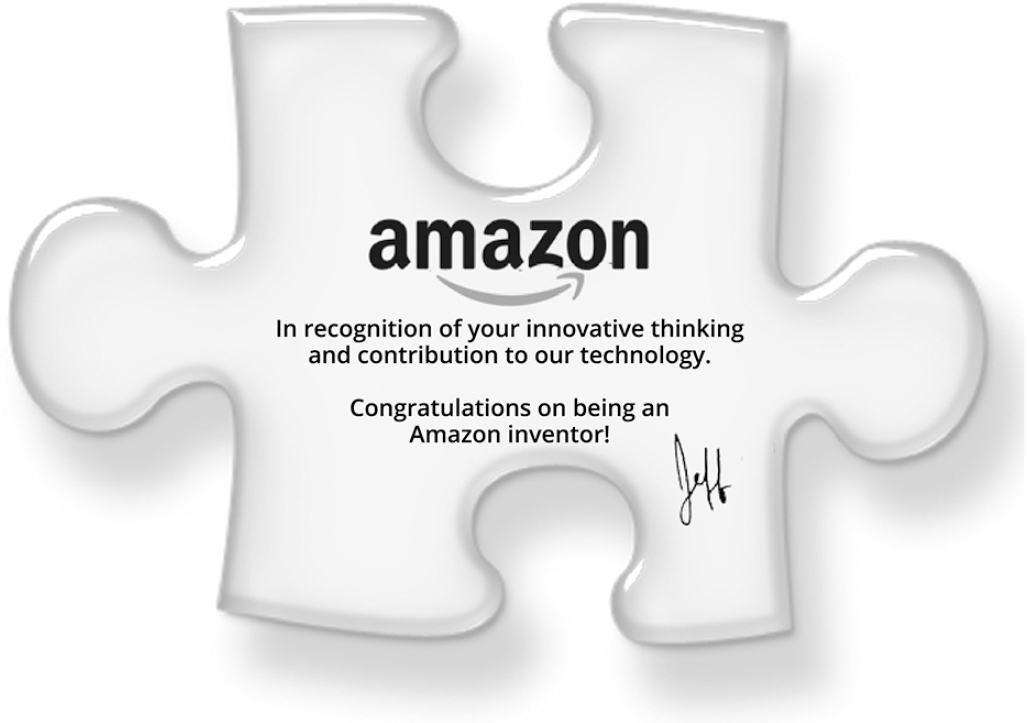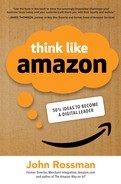
GAMES FOR INNOVATION
Spur Invention in Fun Ways
The present is theirs; the future, for which I really worked, is mine.
—Nicola Tesla
One of the most valuable honors an Amazon employee can earn is a puzzle piece made of clear or blue acrylic resin. Outside Amazon, the thing is basically worthless. Inside Amazon, it is a medal of honor. These are called “patent awards.” Amazon inventors receive a clear puzzle piece when one of their inventions is filed. If a patent ensues, they receive a blue puzzle piece with their name, the patent number, and the date of issuance.
Some of the most successful inventors at Amazon have large puzzles with dozens of pieces on their desks. But no one out-invents the big dog. Walk into Jeff’s conference room, and you’ll find the word “patent” in blue puzzle pieces framed by clear puzzle pieces.1 Digital versions of these patent awards are also displayed on the company’s intranet. They distinguish an employee’s profile in much the same way experience points or collected items distinguish a gamer’s video game profile. This is not by accident.
Video game designers have long understood that if you build an interaction into your game, the player is going to interact with it. Anytime a game responds to its players, they are going to keep playing. Give them a door, and they will walk through it. Give them a weapon, and they will use it. Give them an incentive to invent, and they will invent. It’s human nature. Simply put, that’s how Amazon generates an absurdly large number of inventions and patents. They gamified the process (Figure 14.1).

Figure 14.1 Congratulations on Being an Amazon Inventor!
Source: Adapted from Todd Bishop, “Legal Puzzle: Amazon and Former Employee Set for Trial in Unusual Patent Dispute,” GeekWire, July 8, 2013.
THE FUTURE GAME
In his 2013 letter to shareholders, Bezos described Amazon as a “large, inventive team” with “a patient, pioneering, customer-obsessed culture.” He described great innovations, large and small, happening every day on behalf of customers at all levels throughout the company.2 “This decentralized distribution of invention throughout the company—not limited to the company’s senior leaders—is the only way to get robust, high-throughput innovation. What we’re doing is challenging and fun—we get to work in the future,” wrote Bezos.3
Of course, in every game there are winners and losers. This does not bother Bezos. In fact, he embraces the fact that failure is part of invention. He understands that failure is not optional. “We understand that, and believe in failing early and iterating until we get it right. When this process works, it means our failures are relatively small in size (most experiments can start small), and when we hit on something that is really working for customers, we double-down on it with hopes to turn it into an even bigger success. However, it’s not always as clean as that. Inventing is messy, and over time, it’s certain that we’ll fail at some big bets too.”4
WHAT DO I WIN?
When you are an employee of a company, the intellectual property you develop is typically owned by the company. So what’s in it for the employee? Sometimes recognition is enough, especially if your employee has bought into your culture and is playing for the future (and future stock options). But there is no end to the ways you can motivate employees and gamify innovation in your organization.
In addition to finding a way to recognize innovation—such as a chunk of acrylic resin—there are many approaches to inspiring people to collaborate and be excited about the process. Games and contests can be exciting because they allow for a different mindset and a break from the operational status quo.
A hackathon, in which you put “work” aside for two or three days to focus on a specific challenge, is one such approach. Frame the contest in a way that is suitable to your goals—a new business model, a way to improve a customer experience, or a way to eliminate an operational quality issue or risk. The constraints are that it must be done within a specific time frame. This gets people hacking, looking for shortcuts and new ideas.
Named for the Japanese term meaning “change for the better,” Amazon’s Kaizen program allows employees to join small teams to identify waste and streamline processes. In 2014, more than 2,300 associates participated in 725 kaizen activities, according to the Amazon website. “A team at Amazon’s Las Vegas, Nevada, fulfillment center streamlined the customer returns process, improving productivity 34 percent, eliminating excess walking distance by 128,000 ft. per day, and reducing work in process by 46 percent.”5
In a detailed survey and study of workers at an IBM research lab published by the Journal of Socio-Economics, behavioral economists Susanne Neckermann and Bruno Frey found that naming an award’s recipients and holding a public ceremony had as much of an effect in motivating people as increasing the cash value of a reward from $0 to $1,000.6
Amazon hands out a wide variety of awards and recognitions. Many of these honors are presented at the quarterly all-hands meetings by Jeff Bezos or another senior leader. Each has its own subtext. For example, the Just Do It Award is given to an employee found demonstrating the leadership principle of ownership. The subtext of this prize is that it’s never “not your job” to do the right thing. The Bar Raiser Award is bestowed upon those employees who can identify and hire talent guaranteed to markedly improve the company’s collective IQ, capacity, and capability. The subtext of this award is that the engine driving Amazon is constant improvement. Jeff famously put the philosophy of the Bar Raiser Award this way: five years after an employee was hired, that employee should think, “I’m glad I got hired when I did because I wouldn’t get hired now.”7
It doesn’t always need to be an award. Every holiday season as the logistics operations organization prepares for another peak of inventory and orders to manage, Jeff Wilke wears flannel shirts to recognize the hard work and sacrifices that the hundreds of thousands of people working in the Amazon fulfillment centers are doing and to send a safety-first message.
Then there’s the “empty chair.” Bezos is known to leave one seat open at a conference table to inform all attendees that they should consider that seat occupied by their customer, “the most important person in the room.”8
Ultimately, these symbolic gestures are highly calculated and often repeated messages created to reinforce Amazon’s leadership principles. It’s a tactic Bezos has used since the beginning. He has proven time and again that if you give an employee—any employee—a door, he or she will walk through it. And in some cases, these incentives will have a considerable impact on your bottom line. Which brings us to the door desk.
